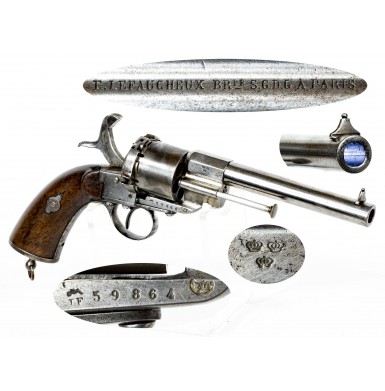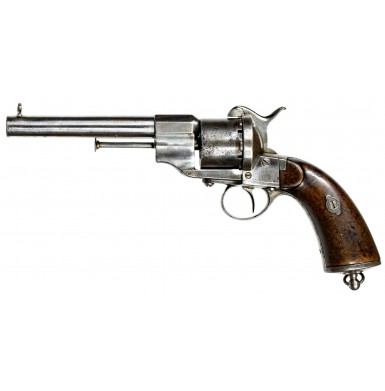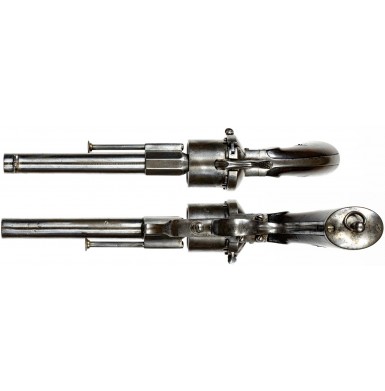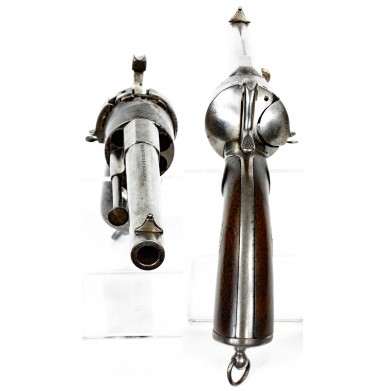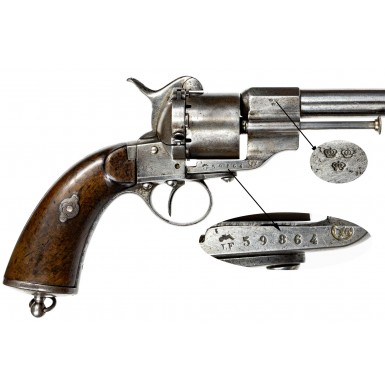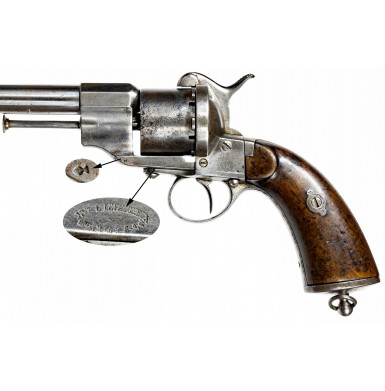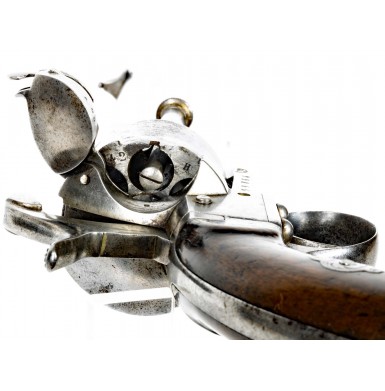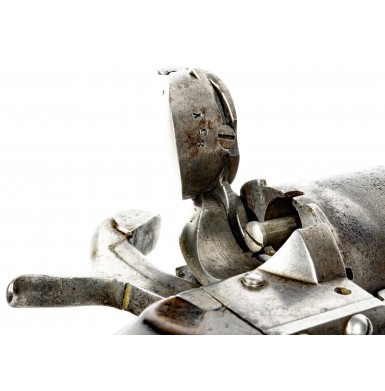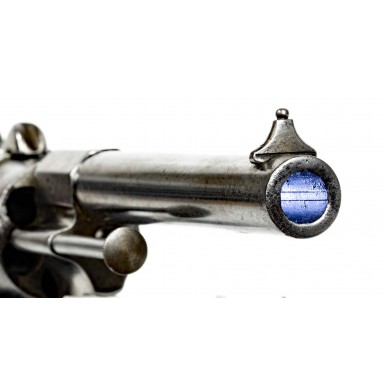Extremely Rare Swedish Naval Model 1863 Pinfire Revolver - Only 890 Issued
- Product Code: FHG-2231-SOLD
- Availability: Out Of Stock
-
$1.00
In many ways the large bore pinfire revolvers, based upon the patents of French gunmakers Casimir and Eugene Lefaucheux were the most modern and advanced handguns to see military service during the mid-19th century. Casimir Lefaucheux (1802-1852) had patented his self-contained pinfire ammunition in 1836, improving upon work done by French gunsmith Jean Samuel Pauly. Casimir’s work had been primarily in the perfection of the ammunition and in creating breechloading sporting long arms that could use the ammunition. In a period when the standard firearms were muzzleloading, percussion ignition weapons, the self-contained metallic cartridge of Casimir Lefaucheux and his breechloading firearms were truly revolutionary innovations. When Eugene took control of his father’s company at the age of 21, the year after his father’s death, Eugene took the business to the next level. Eugene, like many inventors of the period, was not opposed to taking advantage of another person’s innovations. He had seen the wide variety of “modern” firearms displayed at the Crystal Palace Exhibition in London during 1851, many of which certainly impressed him. The displays certainly lead Eugene to pursue the design of a revolver that would incorporate the Lefaucheux patent self-contained pinfire ammunition.
In 1854, the younger Lefaucheux patented a single-action pinfire revolver. The patent drawings essentially depict an early Colt Model 1851 “square back” Navy revolver, but incorporate a bored-through cylinder, a hinged loading gate and an ejector rod. Interestingly, one of the primary components of the design was a bored-through cylinder, a concept that Lefaucheux successfully patented in France on April 15, 1854 and in England some twelve days later on April 27. Why Lefaucheux did not pursue patent protection in the United States at the same time is unclear. However, it allowed Rollin White to patent the same concept nearly a year later on April 2, 1855. This set the stage for Smith & Wesson, as the assignee of the White patent to become one of the world’s foremost revolver manufacturers.
Despite the major advancement from a muzzleloading, single shot, percussion pistol, Lefaucheux’s Model 1854 revolver design initially met with strong resistance from the conservative military hierarchies of the world. While nearly a dozen countries would adopt Lefaucheux revolvers for at least limited military use in the coming decade, the adoption was not swift or uniform.
It would be the French Navy that lead the way and become the first major world military branch of service to actively pursue such a modern handgun design. In 1855, the French Navy tested designs by Colt (Model 1851 Navy), Adams (Model 1854 Beaumont-Adams), as well as a number of other conventional percussion revolver designs. However, the rather practical members of the French naval board of ordnance realized that naval service was the perfect venue for self-contained metallic cartridge arms. As such, they determined that only such a weapon would be acceptable to replace their current single-shot percussion pistols. At that time, that meant that only the Lefaucheux design met the newly established specifications. In 1858, the French Navy officially adopted Lefaucheux’s M1854 revolver as the Pistolet-Revolver Model 1858. Like the original M1854 design, the new French naval model was an open-top single action, 6-shot, 12mm revolver. The revolvers had nominally 6” round barrels with a small octagonal section where the barrel met the frame. A loading gate on the right side of the frame allowed access to the chambers of the cylinder and an ejector rod mounted to the right side of the frame allowed the removal of spent cartridge cases. The rudimentary sights used a notch in the hammer nose as a rear sight and a tall dovetailed front sight with a triangular base with a barleycorn style bead at its top. The guns were produced at the French national armory at St. Etienne and were delivered with a high polish “in the white” finish, of the same style as the US “National Armory Bright” finish. The revolver had two-piece wood grips and a lanyard ring in the butt. These French Navy revolvers were later improved with some minor upgrades as the M1858N and were then further improved with a new double-action lockwork as the Model 1873. With the adoption by the French Navy, a number of other European nations started to adopt the Lefaucheux design on at least a limited basis. The Danes adopted a variant of the French M1858 as the Model 1861 and continued to use the system through their Model 1865 and 1871 patterns. The Spanish adopted a variant of the M1858 as the Trubois Model 1858, the Orbea Model 1858 and the Oviego Model 1858; all named for the Spanish arsenal that produced them. The Italian Police also adopted the design as the Model 1861 Carabinieri (police) revolver. The revolver was also adopted on a limited basis by the militaries of Sweden and Norway as the Model 1863 and by the Russian military as well. The commercial Model 1854 revolvers were utilized on a fairly wide basis during the US Civil War as well, with at least 13,000 being purchased by the US Ordnance Department and an unknown, but certainly significant amount acquired by the Confederacy as well.
Interestingly, despite the inroads that the Lefaucheux design made with a number of world military services, the single-shot percussion pistol remained the backbone of most European cavalry forces through the end of the Franco-Prussian War period. Instead, the Lefaucheux design tended to see service in limited, specialty troop rolls, with branches of service like the navy and artillery being more likely to utilize the advanced design.
In 1863, the Kingdom of Sweden placed an order for 2,000 Lefaucheux Revolvers of the French Naval Model 1858 pattern. The initial order included 100 rounds of ammunition for each revolver; a relatively small amount of ammunition for an arm that might see combat use. The Swedes, like most of their European counterparts did not issue these new revolvers to the cavalry, but to other branches of service. In this case 1,110 were issued to the Swedish Artillery and the remaining 890 were issued to the Swedish Navy. Like the French M1858 revolvers the Swedish Lefaucheux pistols were finished “in the white” and followed the same profile and design specifications. The Swedish revolvers can only be identified by the application of the mark of the coat of arms of the Kingdom of Sweden on the right flat of the small octagonal portion of the barrel where it meets the frame. This mark is three crowns (tre kronor) arranged in two rows with two crowns in the upper row and a single crown in the lower row, centered under the upper two crowns. All two thousand revolvers purchased by Sweden received this national mark. The guns issued to the artillery were not marked in any additional way, although unit markings occasionally appear on the right side of the frame, forward of the grip. The 890 pistols issued to the Swedish Navy were additionally marked with a small stamp on the lower leading edge of the frame, forward of the cylinder. In his excellent reference work System Lefaucheux by Chris Curtis, this mark is referred to as “resembling a crown”, although to me it looks more like a stylized arrowhead. The mark typically appears on the right side, but sometimes appears on the left side of the frame. These Navy marked pistols are occasionally found with an additional frame mark that resembles a cross within a circle, which is the equivalent of a “sold out of service” or “surplus mark”.
In April of 1871, the Swedish military adopted a new, 11mm centerfire pistol designated as the Model 1871. This revolver was a joint design by Eugene Lefaucheux and August Francotte of Liege. These revolvers were initially used to arm those in the artillery and navy who had not received the earlier M1863 pistols. The guns were subsequently issued to the infantry for those who were allowed sidearms. By 1879, some of the Swedish cavalry units were finally receiving the new M1871 revolvers and were finally discarding their incredibly obsolete single shot, muzzle loading pistol. Due to the widespread adoption of the new 11mm centerfire revolver cartridge, the Swedish military ordered all of the older Model 1863 Pinfire revolvers be turned in during 1879 for alteration to 11mm centerfire. The modifications included the addition of a centerfire firing pin on the hammer and milling a firing pin channel in the frame. Additionally, the rear edge of the each of the chambers in the cylinder was milled to accept the rim of the new cartridge. The newly modified revolvers were designated as Model 1863/79. This wholesale recall and modification of the Model 1863 revolvers means that today, finding an original pinfire, unmodified Model 1863 revolver is extremely difficult, considering only 2,000 M1863 revolvers were obtained in the first place.
Offered here is an extremely rare Swedish Navy Model 1863 Pinfire Revolver. As noted, only 890 of the 2,000 M1863 revolvers were issued to the Swedish Navy and due to the 1879 recall, only a handful of original pinfire M1863 revolvers are believed to remain in existence. The gun remains in about GOOD+ condition and like most military arms shows some minor repairs and small replacement parts. The right side of the frame shows the standard {CROWN}/LF Lefaucheux trademark as a prefix to the serial number. The serial number is 59864. It is the typical martial pattern single action pinfire pistol with an octagon to round barrel and a nominal caliber of 12mm (the bore measures 11.35mm). The top of the round part of the 6 1/8” barrel is marked in a single line:
E. LEFAUCHEUX BRTÉ S.G.D.G. A PARIS
The left side of the frame is marked with the usual two line oval Lefaucheux patent cartouche, which reads INVON E. LEFAUCHEUX / BREVETÉ SGDG (PARIS). The initials before “PARIS” are the equivalent of the US statement “registered patent”. The revolver is additionally marked with a deeply struck small “arrowhead” or “crown” Swedish Navy mark on the lower left side of the frame, in front of the cylinder and with the cryptic “cross in circle” Swedish Navy sold out of service mark in the same location on the right side of the frame. These markings, in conjunction with the three Swedish crowns, allow us to know this is a Swedish Naval Model 1863 Revolver.
Like most Lefaucheux revolvers, the gun is assembly marked to aid in reassembling these non-interchangeable guns. The interior surface of the recoil shield face, inside the frame is stamped with the alphanumeric assembly mark 85 Y. This same mark is found inside the loading gate as well. As is the case with many military arms that saw service and were ever repaired or rebuilt, this gun has mismatched assembly numbers on the cylinder, which is stamped 42 H and grips that are stamped S and scratch numbered 54 on their interiors.
The revolver remains “in the white” and has been lightly cleaned in the past to try to recreate the original bright metal military finish. The metal is toning down to a silvery gray patina and some of the markings are slightly worn with portions of them a little light due to the cleaning. The metal shows scattered surface oxidation and age discoloration on the barrel and frame with freckled areas of salt and pepper and some very lightly scattered pinpricking. There are some tiny patches of more moderate pinpricking on the barrel, near the muzzle. The cylinder shows more dark discoloration as well as some patches of light to moderate pinpricking and some light surface pitting, likely the result of being stored where the cylinder was in contact with fabric for a long period of time. There is also some scattered surface oxidation and roughness on the face of the cylinder. The revolver has several replaced screws, a not uncommon occurrence on military handguns that saw any real service. The four screws on the bottom of the frame are old replacements. As noted, the cylinder is a period replacement as well, from another M1863 revolver. The loading gate hinge pin has been replaced and the locking catch has been repaired. This is quite common and often this delicate catch is broken or missing. The loading gate still functions correctly, and locks closed as it should. The revolver remains mechanically functional and times, indexes and locks up exactly as it should. The bore of the revolver is in GOOD+ condition and retains strong rifling along its length. The bore is partly bright with areas of darker oxidation and scattered light to moderate pitting along its length. The revolver retains the original ejector rod, which remains fully functional. This is a part that is often broken, damaged, repaired or replaced. The revolver also retains its original front sight, complete with the barleycorn bead on top and the rear sighting notch is still quite useable in the hammer nose. The original lanyard ring remains in place in the butt of the revolver as well. The grips are in about good condition and show wear commensurate with the condition and wear of the revolver. They are solid and free of any breaks or repairs. There is a small, surface grain crack in the right grip where it meets the frame. Otherwise the grips show on the usual scattered bumps, dings and mars normally encountered on a 19th century military handgun.
Overall, this is a solid, if used and somewhat worn example of an extremely rare Swedish Navy Model 1863 Pinfire Revolver. All Swedish military Model 1863 revolvers are scarce as only 2,000 were acquired. Only 890 were issued to the Navy, making the naval version even more scarce. As nearly all Model 1863 revolvers were subsequently upgraded to Model 1863/79 11mm centerfire revolvers, finding a Swedish M1863 in its original pinfire configuration is incredibly difficult. This would be a fantastic addition to any advanced collection of pinfire revolvers or one that concentrates on 19th century European military handguns. These revolvers rarely appear for sale and other than the example shown in Chris Curtis’ book System Lefaucheux I have only ever seen one other example of a Swedish Model 1863 Pinfire Revolver. Do not miss your opportunity to add one of these very rare revolvers to your collection, as you may not have another opportunity to do so.
SOLD
Tags: Extremely, Rare, Swedish, Naval, Model, 1863, Pinfire, Revolver, Only, 890, Issued

